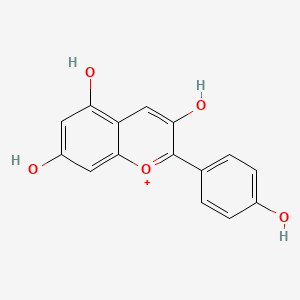| MeSH term | MeSH ID | Detail |
|---|---|---|
| Cystitis | D003556 | 23 associated lipids |
| Parkinsonian Disorders | D020734 | 20 associated lipids |
Pelargonidin
Pelargonidin is a lipid of Polyketides (PK) class. The involved functions are known as Uptake, Intestinal Absorption, glucose uptake, Process and Metabolic Inhibition. Pelargonidin often locates in Serosal, Mucous Membrane, brush border membrane, Membrane and Cell surface. The associated genes with Pelargonidin are SLC5A1 gene, SLC2A2 gene, Homologous Gene, F3 gene and CRSP3 gene. The related experimental models are Knock-out.
Cross Reference
Introduction
To understand associated biological information of Pelargonidin, we collected biological information of abnormalities, associated pathways, cellular/molecular locations, biological functions, related genes/proteins, lipids and common seen animal/experimental models with organized paragraphs from literatures.
What diseases are associated with Pelargonidin?
There are no associated biomedical information in the current reference collection.
Possible diseases from mapped MeSH terms on references
We collected disease MeSH terms mapped to the references associated with Pelargonidin
PubChem Associated disorders and diseases
What pathways are associated with Pelargonidin
There are no associated biomedical information in the current reference collection.
PubChem Biomolecular Interactions and Pathways
Link to PubChem Biomolecular Interactions and PathwaysWhat cellular locations are associated with Pelargonidin?
Visualization in cellular structure
Associated locations are in red color. Not associated locations are in black.
Related references are published most in these journals:
| Location | Cross reference | Weighted score | Related literatures |
|---|
What functions are associated with Pelargonidin?
Related references are published most in these journals:
| Function | Cross reference | Weighted score | Related literatures |
|---|
What lipids are associated with Pelargonidin?
There are no associated biomedical information in the current reference collection.
What genes are associated with Pelargonidin?
Related references are published most in these journals:
| Gene | Cross reference | Weighted score | Related literatures |
|---|
What common seen animal models are associated with Pelargonidin?
Knock-out
Knock-out are used in the study 'MATE2 mediates vacuolar sequestration of flavonoid glycosides and glycoside malonates in Medicago truncatula.' (Zhao J et al., 2011).
Related references are published most in these journals:
| Model | Cross reference | Weighted score | Related literatures |
|---|
NCBI Entrez Crosslinks
All references with Pelargonidin
Download all related citations| Authors | Title | Published | Journal | PubMed Link |
|---|---|---|---|---|
| Stewart D et al. | Metabolomic approach to identifying bioactive compounds in berries: advances toward fruit nutritional enhancement. | 2007 | Mol Nutr Food Res | pmid:17492796 |
| Kottra G and Daniel H | Flavonoid glycosides are not transported by the human Na+/glucose transporter when expressed in Xenopus laevis oocytes, but effectively inhibit electrogenic glucose uptake. | 2007 | J. Pharmacol. Exp. Ther. | pmid:17495124 |
| Felgines C et al. | Strawberry pelargonidin glycosides are excreted in urine as intact glycosides and glucuronidated pelargonidin derivatives in rats. | 2007 | Br. J. Nutr. | pmid:17559698 |
| Nicoué EE et al. | Anthocyanins in wild blueberries of Quebec: extraction and identification. | 2007 | J. Agric. Food Chem. | pmid:17579428 |
| Abraham SK et al. | Antigenotoxic effects of the phytoestrogen pelargonidin chloride and the polyphenol chlorogenic acid. | 2007 | Mol Nutr Food Res | pmid:17579891 |
| Grimplet J et al. | Tissue-specific mRNA expression profiling in grape berry tissues. | 2007 | BMC Genomics | pmid:17584945 |
| Nakatsuka T et al. | Production of red-flowered plants by genetic engineering of multiple flavonoid biosynthetic genes. | 2007 | Plant Cell Rep. | pmid:17639403 |
| Kern M et al. | Limited stability in cell culture medium and hydrogen peroxide formation affect the growth inhibitory properties of delphinidin and its degradation product gallic acid. | 2007 | Mol Nutr Food Res | pmid:17729219 |
| Estévez L and Mosquera RA | A density functional theory study on pelargonidin. | 2007 | J Phys Chem A | pmid:17929785 |
| de Brito ES et al. | Anthocyanins present in selected tropical fruits: acerola, jambolão, jussara, and guajiru. | 2007 | J. Agric. Food Chem. | pmid:17929888 |
| Yan Y et al. | High-yield anthocyanin biosynthesis in engineered Escherichia coli. | 2008 | Biotechnol. Bioeng. | pmid:18023053 |
| Jordheim M et al. | Molar absorptivities and reducing capacity of pyranoanthocyanins and other anthocyanins. | 2007 | J. Agric. Food Chem. | pmid:18047275 |
| Hosseinian FS and Beta T | Saskatoon and wild blueberries have higher anthocyanin contents than other Manitoba berries. | 2007 | J. Agric. Food Chem. | pmid:18052240 |
| Bakowska-Barczak AM et al. | Survey of bioactive components in Western Canadian berries. | 2007 | Can. J. Physiol. Pharmacol. | pmid:18066116 |
| Zhang Y et al. | Isolation and identification of strawberry phenolics with antioxidant and human cancer cell antiproliferative properties. | 2008 | J. Agric. Food Chem. | pmid:18211028 |
| Hämäläinen M et al. | Anti-inflammatory effects of flavonoids: genistein, kaempferol, quercetin, and daidzein inhibit STAT-1 and NF-kappaB activations, whereas flavone, isorhamnetin, naringenin, and pelargonidin inhibit only NF-kappaB activation along with their inhibitory effect on iNOS expression and NO production in activated macrophages. | 2007 | Mediators Inflamm. | pmid:18274639 |
| Tulio AZ et al. | Cyanidin 3-rutinoside and cyanidin 3-xylosylrutinoside as primary phenolic antioxidants in black raspberry. | 2008 | J. Agric. Food Chem. | pmid:18290621 |
| Aksamit-Stachurska A et al. | Glycosyltransferase efficiently controls phenylpropanoid pathway. | 2008 | BMC Biotechnol. | pmid:18321380 |
| Vauzour D et al. | Peroxynitrite induced formation of the neurotoxins 5-S-cysteinyl-dopamine and DHBT-1: implications for Parkinson's disease and protection by polyphenols. | 2008 | Arch. Biochem. Biophys. | pmid:18394421 |
| Pawlowska AM et al. | Quali-quantitative analyses of Flavonoids of Morus nigra L. and Morus alba L. (Moraceae) fruits. | 2008 | J. Agric. Food Chem. | pmid:18412362 |
